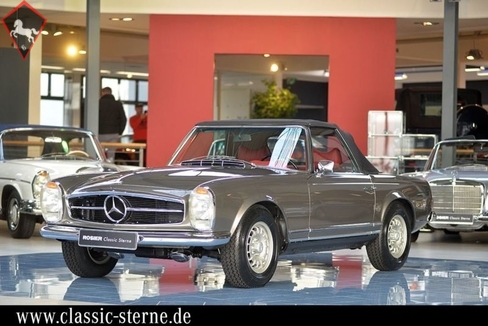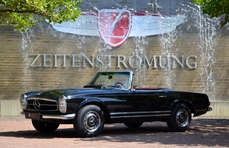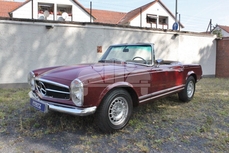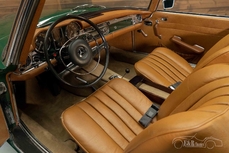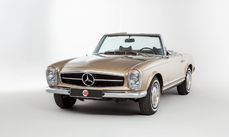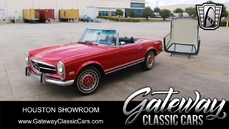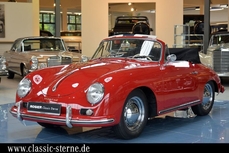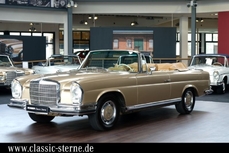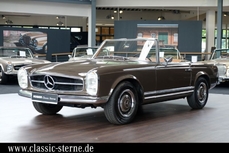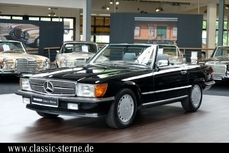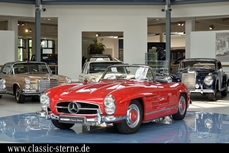Mercedes-Benz 280SL w113 SL Pagode W113 5-Gang Qualitätsrestaurierung 1970
General description :
Interne Fahrzeugnr.: KRE280SL
Ansprechpartner: Gross, Dietrich - 0441 209780 12
Dieser Mercedes-Benz 280SL aus 1970 wurde am 05. März 1969 im Werk fertiggestellt und am 25. März 1970 an seinen ersten Besitzer in den USA ausgeliefert. Er verblieb all die Jahre in den USA und gehörte zuletzt James E. Ruscoe in Edison, New Jersey USA. Im Mai 2014 verkaufte er den Wagen. Der Wagen kam über die Niederlande zurück in sein Geburtsland Deutschland.
Sein neuer Besitzer, ein Mercedes Enthusiast aus Nordrhein-Westfalen, ließ den Wagen umfangreich restaurieren. Die Pagode erhielt die elegante Farbgebung DB 172 anthrazitgrau-metallic mit schwarzem Hardtop, sowie eine neue Lederausstattung in 242 rot. Eine tolle Farbkombination, die dem Wagen enorme Ausstrahlung verschafft. Die gesamte Technik wurde überarbeitet. Die Hinterachsübersetzung wurde auf deutschen Stand (3.69) gebracht, die Vorderachse und die Hinterachse komplett überholt. Der Motor wurde komplett überholt, fast alle Nebenaggregate sind neu oder generalüberholt. Ein neues 5-Gang Getrag Schaltgetriebe wurde verbaut.
Der gesamte Kabelbaum der Fahrzeugelektrik wurde erneuert. Neue Koni Stoßdämpfer und eine neue Edelstahlauspuffanlage wurden eingebaut. Die Leichtmetallfelgen mit der breiteren Bereifung unterstreichen das tolle Erscheinungsbild. Eine Pagode wie aus dem Bilderbuch.
Lassen Sie sich einfangen von ihrem Charme.
This Mercedes-Benz 280SL from 1970 was completed on March 5, 1969 in the factory and delivered on March 25, 1970 to its first owner in the United States. It remained in the US all these years and most recently belonged to James E. Ruscoe of Edison, New Jersey.
In May 2014, he sold the car. The car came over the Netherlands back to his native coutry Germany. His new owner, a Mercedes enthusiast from North Rhine-Westphalia (Germany), had the car extensively restored. The pagoda received the elegant coloring DB 172 anthracite gray metallic with black hardtop, as well as a new leather interior in 242 red. A great color combination, which gives the car enormous appeal. The entire technique has been revised. The rear axle ratio was brought to German level (3.69), the front axle and the rear axle completely overhauled. The engine was completely overhauled, almost all auxiliary units are new or overhauled. A new 5-speed Getrag transmission was installed. The entire wiring harness of the vehicle electrics has been renewed. New Koni shock absorbers and a new stainless steel exhaust system were installed. The alloy wheels with the wider tires underline the great appearance.
A pagoda like a storybook.
Let yourself be captivated by its charm.
Für weitere Detailinformationen zu diesem Fahrzeug oder Interesse an einem Besichtigungstermin kontaktieren Sie unser Verkaufsteam Dietrich Gross 0441-209780-12 oder Daniel Krzykowski 0441-209780- 11.Unseren aktuellen Fahrzeugbestand finden Sie unter http://www.classic-sterne.de
Zubehörangaben ohne Gewähr, Änderungen, Zwischenverkauf und Irrtümer vorbehalten!
powered by two S
1970 Mercedes-Benz 280SL w113 SL Pagode W113 5-Gang Qualitätsrestaurierung is listed for sale on ClassicDigest in Bremer Heerstraße 267DE-26135 Oldenburg by Rosier Classic Sterne GmbH for €198000.
Car Facts
Car type : Car Make : Mercedes-Benz Model : 280SL w113 Model Version : SL Pagode W113 5-Gang Qualitätsrestaurierung Engine size : 0.0 Model Year : 1970 Sub type : Convertible Location : Bremer Heerstraße 267DE-26135 Oldenburg Vehicle Registration : Undefined
198000 €
Seller Information
Rosier Classic Sterne GmbH
Rosier Classic Sterne GmbH
+49 (0)441 2492418091
Rosier Classic Sterne GmbH
+49 (0)441 2492418091
People who viewed this Mercedes-Benz 280SL w113 also viewed similar Mercedes-Benz listed at ClassicDigest
Other cars listed for sale by this dealer
About Mercedes-Benz
In the annals of automotive history, the journey of Mercedes-Benz is a tale that unfolds with the ingenuity of its founding pioneers. In the year 1886, Karl Benz crafted the Benz Patent Motorwagen, a creation that would go down in history as the world's inaugural automobile. Unbeknownst to him, this moment marked the genesis of what would evolve into the most illustrious premium car manufacturer globally. The financial underpinning of this pioneering venture, interestingly, was provided by Karl Benz's wife, Bertha Benz, demonstrating a remarkable partnership that would set the tone for Mercedes-Benz's legacy.A parallel narrative emerged not far away, as Daimler-Motoren-Gesellschaft, founded by Gottlieb Daimler and Wilhelm Maybach, entered the scene. In 1901, they unveiled their automobile under the now-famous moniker "Mercedes," meaning "godsend" in Spanish. This name was bestowed upon the car at the behest of Emil Jellinek's daughter, the distributor for Daimler-Motoren-Gesellschaft. The wheels of innovation were set in motion.
Fast forward to 1926, a pivotal year that witnessed the merger of Daimler with Benz & Cie., culminating in the birth of Daimler-Benz. The amalgamation saw the adoption of "Mercedes-Benz" as the distinguished trademark for their automobiles, fusing the legacies of two visionary entities into one.
Contrary to perceptions of conservatism, the trajectory of Daimler-Benz unfolds as a chronicle of industry firsts. From the introduction of the honeycomb radiator to the float carburetor, and the pioneering implementation of four-wheel brakes in 1924, Daimler-Benz consistently pushed the boundaries of automotive innovation. The diesel-powered Mercedes-Benz 260 D in 1936 marked the inception of diesel engines in passenger cars. The iconic Mercedes-Benz 300SL Gullwing made history as the first car with direct fuel injection, albeit the Gutbrod's tiny 2-stroke engine can claim precedence.
Safety innovations became a hallmark, with Béla Barényi's patented safety cell design in the "Ponton"-models in 1951, featuring front and rear crumple zones. The W116 450SEL 6.9 saw the introduction of the Anti-Lock Brake system (ABS), another pioneering safety feature. From the first production airbags and beyond, the legacy of "firsts" continued to be etched into the fabric of Daimler-Benz.
Over its centennial journey, Mercedes-Benz has not merely produced cars but has sculpted automotive icons. The SSKL, 710 SSK Trossi Roadster, 770K Grosser, 540K Spezial Roadster, 300SL Gullwing, w100 600 Pullman, w111 280SE 3.5 Flachkühler, w113 230SL Pagoda, w109 300 SEL 6.3, and w201 2.3-16 Cosworth stand testament to the brand's commitment to engineering excellence.
The roaring Silver Arrows, or "Silberpfeile," including the W 25, W 125, W154, W165, and W196, created a legacy of dominance on the racetrack. These machines were not merely cars; they were expressions of precision, speed, and an indomitable spirit that left their competitors in the dust.
As Mercedes-Benz marches into the future, it does so not just as an automaker but as a custodian of a legacy, a torchbearer of innovation, and a beacon of automotive excellence. The road ahead is sure to witness the continued fusion of cutting-edge technology, timeless design, and an unwavering commitment to setting new standards in the world of automobiles.
One luminary figure who left an indelible mark was Béla Barényi, often heralded as the "father of passive safety" for his pioneering work in safety engineering. His patented safety cell design, featuring front and rear crumple zones, became a hallmark of Mercedes-Benz's commitment to occupant safety, setting new standards that reverberated throughout the automotive world.
Moving through the chronicles, the collaborative genius of Wilhelm Maybach, alongside Gottlieb Daimler, laid the foundation for Daimler-Motoren-Gesellschaft. Their innovations not only birthed the first Mercedes but established a culture of relentless pursuit of technological excellence that remains integral to Mercedes-Benz's DNA.
In the post-merger era of 1926, Ferdinand Porsche emerged as a prominent figure within Mercedes-Benz. His work on the Mercedes-Benz S-Type, a supercharged race car, garnered acclaim and set the stage for a legacy that extended far beyond the marque. Porsche's impact would later extend to his eponymous company, but his influence at Mercedes-Benz during those formative years was pivotal.
As the 20th century progressed, the legendary Rudolf Uhlenhaut emerged as a key figure. Uhlenhaut, an accomplished engineer and the driving force behind the iconic Silver Arrows, played a crucial role in Mercedes-Benz's dominance in motorsports. His engineering prowess and attention to detail were instrumental in creating some of the most formidable racing cars of the era.
In the latter half of the century, figures like Bruno Sacco, the head of design at Mercedes-Benz from 1975 to 1999, left an indelible imprint on the brand's aesthetic identity. Sacco's design philosophy, characterized by clean lines and timeless elegance, shaped iconic models like the W126 S-Class and the W201 190E, solidifying Mercedes-Benz's reputation for luxury and sophistication.
The narrative would be incomplete without acknowledging the contributions of engineers like Hans Scherenberg, whose leadership in the 1970s ushered in a new era of technological innovation at Mercedes-Benz. Scherenberg's tenure saw the development of groundbreaking technologies, including the Anti-Lock Brake system (ABS) and the introduction of airbags in production cars.
